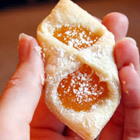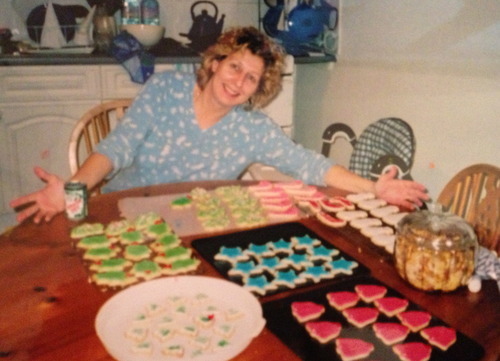Although New Year's Cookies aren't a tradition in my family, I do share a German heritage with them and thought they would be fun to make today - before the resolutions begin! New Year's Cookies, also called "Porzelchen" (High German) or "Niejoash koake" (Low German), have been made by German Mennonites for many generations. (Scandinavian and Russian Mennonites also have versions of this recipe.) They were traditionally made the day of New Year's Eve, to be eaten during "Watchnight" services in the Mennonite church (and usually finished off the next day). Watchnight was the spiritual alternative to the drunken revelry associated with New Year's Eve.
Consider this recollection from Violet, in her blog Promptings: "That late-ish New Year's Eve church service, consisting of hymns, testimonies and lots of prayers, always ended with lunch in the church basement - definitely the highlight of the evening for us kids. Portzelky was the star of the menu - iced, plain, coated in a sugar-cinnamon mixture, or dusted in icing sugar. Some were soft as marshmallows, others were chewy. Some cooks filled theirs with apple bits, but most with raisins. It always amazed me how one food could turn out so differently in the hands of a variety of cooks."
"Cookie" is actually a misnomer; Porzelchen are not cookies at all, but rather a type of fritter or doughnut with raisins. The High German name means "tumbling over" because they are said to turn over by themselves in the hot oil. Porzelchen are made from a spongy yeast batter with raisins, and dropped by spoon-fulls into hot, deep fat. The dough puffs up, tumbles over, and fries to a golden brown. The "cookies" are then rolled in sugar or glazed.
 |
| Porzelchen recipes use a variety of ingredients. |
And not all traditions relate the "cookies" to Watchnight services either. According to Norma Jost Voth in her book, "Mennonite Foods & Folkways from South Russia," Mennonites gave their Russian neighbors Portselkie when they came and sang for them on New Year's Day. The "cookies" were a symbol of affluence and luxury and carried with them the wish for an abundant year.
 |
| The two-spoon method works for me. |
I used the recipe from the "Mennonite Treasury of Recipes" (Canadian Mennonite Conference. Derksen Printers Ltd., Steinbach, Manitoba, 1982). This is one of the most popular cookbooks in the Mennonite German community and a Canadian bestseller. It can be difficult to find but Derksen Printers sells copies of the soft-cover, spiral-bound book for $20.
I chose not to use raisins because I don't particularly like raisins in my doughnuts. I rolled half of the Porzelchen in a cinnamon-sugar mixture and the other half in powdered sugar. The dough is very sticky and some people use an ice cream scoop, resulting in perfectly round balls. I like the rustic look, so I used two teaspoons to scoop and scrape the dough into the deep fat. The first few turned by themselves but most had to be persuaded.
I enjoyed making these, knowing they've been part of a tradition in German, Russian and Scandinavian families for years. Before we get to the recipe, here's a Low German nursery rhyme from "Off the Mountain Lake Range," a 1958 Mennnonite cookbook produced by the Gopher Historians of Mountain Lake Range (Minnesota) High School:
 Eck sach den Shornsteen Roacke.
Eck sach den Shornsteen Roacke.
Eck visst voll vaut ye moacke.
Ye backte Niejoash Koake.
Yave ye me eane
Dann bliev eck stoane
Yave ye me twea
Dann fang eck aun to goane
Yave ye me drea, fea, feef toaglick
Donn vensch eck you daut gaunse Himmelrick.
English Translation:
I saw your chimney smoking.
I knew what you were making.
You were baking New Year's Cookies.
Give me one -- I stand still.
Give me two -- I start walking.
Give me three, four, five at once,
Then I wish you the Kingdom of Heaven.
PorzelchenI chose not to use raisins because I don't particularly like raisins in my doughnuts. I rolled half of the Porzelchen in a cinnamon-sugar mixture and the other half in powdered sugar. The dough is very sticky and some people use an ice cream scoop, resulting in perfectly round balls. I like the rustic look, so I used two teaspoons to scoop and scrape the dough into the deep fat. The first few turned by themselves but most had to be persuaded.
I enjoyed making these, knowing they've been part of a tradition in German, Russian and Scandinavian families for years. Before we get to the recipe, here's a Low German nursery rhyme from "Off the Mountain Lake Range," a 1958 Mennnonite cookbook produced by the Gopher Historians of Mountain Lake Range (Minnesota) High School:
 Eck sach den Shornsteen Roacke.
Eck sach den Shornsteen Roacke.Eck visst voll vaut ye moacke.
Ye backte Niejoash Koake.
Yave ye me eane
Dann bliev eck stoane
Yave ye me twea
Dann fang eck aun to goane
Yave ye me drea, fea, feef toaglick
Donn vensch eck you daut gaunse Himmelrick.
English Translation:
I saw your chimney smoking.
I knew what you were making.
You were baking New Year's Cookies.
Give me one -- I stand still.
Give me two -- I start walking.
Give me three, four, five at once,
Then I wish you the Kingdom of Heaven.
1 tsp sugar
1/2 c lukewarm water
2 tsp active dry yeast
1/2 c milk
1/2 c water
1/2 Tbsp salt
1 Tbsp sugar
2 tsp baking powder
2 c raisins
3 egg yolks
3 egg whites, beaten
3 c flour
oil (for deep frying)
Dissolve 1 tsp sugar in lukewarm water in a small bowl. Sprinkle with yeast and let stand.
Combine milk, water, salt, remaining sugar, baking powder and raisins in a large bowl.
Beat in egg yolks and yeast.
Stir in flour to make a heavy (rather stiff) batter.
Fold in egg whites.
Cover and set in a warm place until at least doubled in bulk (about 2 hours). The end result is a fairly sticky dough.
Drop by tablespoonful into hot oil (375 degrees Fahrenheit) and fry until golden brown.
Drain on paper towels, then roll in granulated sugar. Or cinnamon-sugar. Or powdered sugar. I shook mine in a bag of cinnamon-sugar; some I did in powdered sugar.
 |
| I shook my "cookies" in cinnamon sugar. |
 |
| Or you can use powdered sugar. |


































